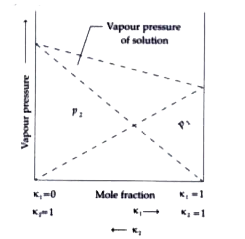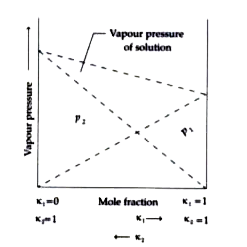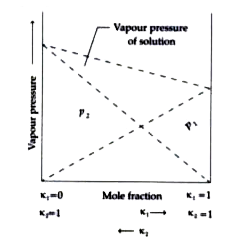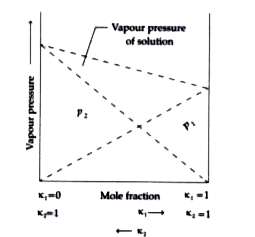For a solution of volatile liquids the partial vapour pressure of each component in solution is directly proportional to
Molarity
Mole fraction
Molality
Normality
The correct Answer is:B
Raoult's law.
Topper's Solved these Questions
Similar Questions
STATEMENT-1 : For solution of volatile liquids, the partial vapour pressure of each component in the solution is directly proportional to its mole fraction.
STATEMENT-2 : Always there will be lowering of vapour pressure on addition of non-volatile solute to a solvent.
STATEMENT-3 : If there is dissociation of non-volatile then the V.P. of solution increases.View SolutionIdentify the law which is stated as:
For any solution, the partial vapour pressure of each volatile component in the solution is directly proportional to its mole fraction.View Solution
Knowledge Check
- Question 1 - Select One
STATEMENT-1 : For solution of volatile liquids, the partial vapour pressure of each component in the solution is directly proportional to its mole fraction.
STATEMENT-2 : Always there will be lowering of vapour pressure on addition of non-volatile solute to a solvent.
STATEMENT-3 : If there is dissociation of non-volatile then the V.P. of solution increases.AT F TBF F TCT T FDF T F - Question 2 - Select One
______ states that for a solution of volatile liquids, the partial vapour pressure of each component of the solution is directly proportional to its mole fraction present in solution.
ABoyle’s lawBDalton’s lawCFaraday’s lawDRaoult’s law - Question 3 - Select One
________ states that for a solution of volatile liquids, the partial vapour pressure of each component of the solution is directly proportional to its mole fraction present in solution
ARaoult’s lawBFaraday’s lawCDalton’s lawDBoyle’s law
The osmotic pressure of a dilute solution is directly proportional to the
View SolutionRead the passage given below and answer the following questions :
Raoult's law states that for a solution of volatile liquids, the partial vapour pressure of each component of the solution is directly proportional to its mole fraction present in solution. Dalton's law of partial pressure states that the total pressure Ptotal over the solution phase in the container will be the sum of the partial pressures of the components of the solution and is given as:
Ptotal= P1+ P2

Which of the following aqueous solutions should have the highest boiling point ?View SolutionRead the passage given below and answer the following questions :
Raoult's law states that for a solution of volatile liquids, the partial vapour pressure of each component of the solution is directly proportional to its mole fraction present in solution. Dalton's law of partial pressure states that the total pressure Ptotal over the solution phase in the container will be the sum of the partial pressures of the components of the solution and is given as:
Ptotal= P1+ P2

What type of deviation from Raoult's law does the above graph represent ?View SolutionRead the passage given below and answer the following questions :
Raoult's law states that for a solution of volatile liquids, the partial vapour pressure of each component of the solution is directly proportional to its mole fraction present in solution. Dalton's law of partial pressure states that the total pressure Ptotal over the solution phase in the container will be the sum of the partial pressures of the components of the solution and is given as:
Ptotal= P1+ P2

A solution of two liquids boils at a temperature more than the boiling point of either of them. What type of deviation will be shown by the solution formed in terms of Raoult' s law ?View SolutionRead the passage given below and answer the following questions :
Raoult's law states that for a solution of volatile liquids, the partial vapour pressure of each component of the solution is directly proportional to its mole fraction present in solution. Dalton's law of partial pressure states that the total pressure Ptotal over the solution phase in the container will be the sum of the partial pressures of the components of the solution and is given as:
Ptotal= P1+ P2

In comparison to a 0.01 M solution of glucose, the depression in freezing point of a 0.01 M MgCl2 solution is _ ___View Solution

